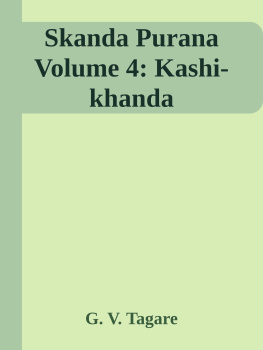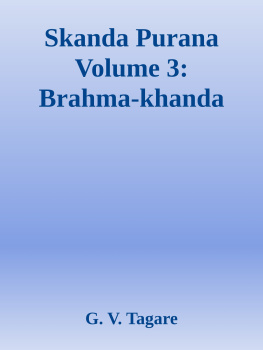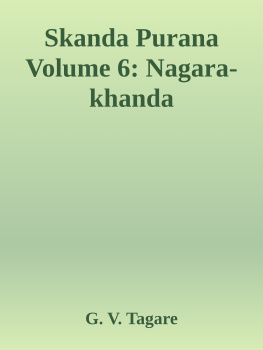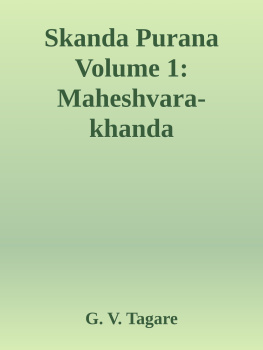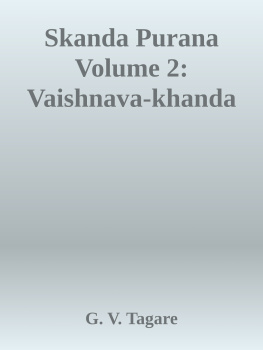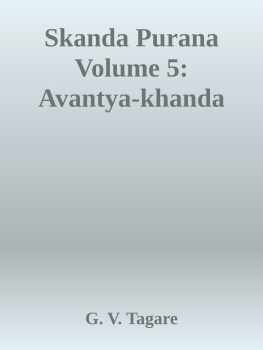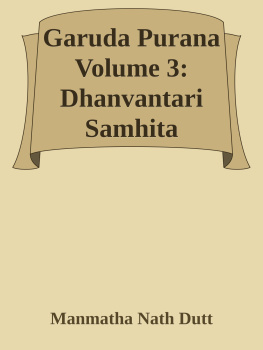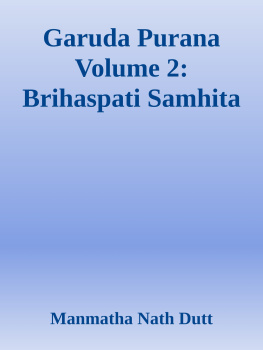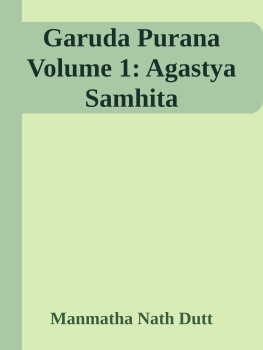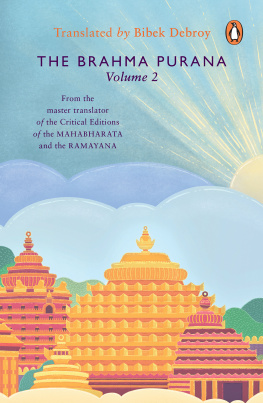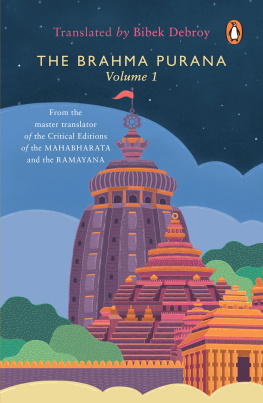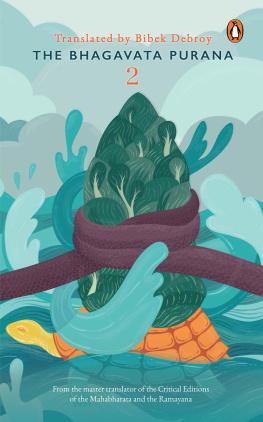G. V. Tagare - Skanda Purana Volume 4: Kashi-khanda
Here you can read online G. V. Tagare - Skanda Purana Volume 4: Kashi-khanda full text of the book (entire story) in english for free. Download pdf and epub, get meaning, cover and reviews about this ebook. genre: Religion. Description of the work, (preface) as well as reviews are available. Best literature library LitArk.com created for fans of good reading and offers a wide selection of genres:
Romance novel
Science fiction
Adventure
Detective
Science
History
Home and family
Prose
Art
Politics
Computer
Non-fiction
Religion
Business
Children
Humor
Choose a favorite category and find really read worthwhile books. Enjoy immersion in the world of imagination, feel the emotions of the characters or learn something new for yourself, make an fascinating discovery.
- Book:Skanda Purana Volume 4: Kashi-khanda
- Author:
- Genre:
- Rating:3 / 5
- Favourites:Add to favourites
- Your mark:
- 60
- 1
- 2
- 3
- 4
- 5
Skanda Purana Volume 4: Kashi-khanda: summary, description and annotation
We offer to read an annotation, description, summary or preface (depends on what the author of the book "Skanda Purana Volume 4: Kashi-khanda" wrote himself). If you haven't found the necessary information about the book — write in the comments, we will try to find it.
Skanda Purana Volume 4: Kashi-khanda — read online for free the complete book (whole text) full work
Below is the text of the book, divided by pages. System saving the place of the last page read, allows you to conveniently read the book "Skanda Purana Volume 4: Kashi-khanda" online for free, without having to search again every time where you left off. Put a bookmark, and you can go to the page where you finished reading at any time.
Font size:
Interval:
Bookmark:
This page describes Purvardha which is section 1 of the English translation of the Skanda Purana, the largest of the eighteen Mahapuranas, preserving the ancient Indian society and Hindu traditions in an encyclopedic format, detailling on topics such as dharma (virtous lifestyle), cosmogony (creation of the universe), mythology (itihasa), genealogy (vamsha) etc.
The Prvrdha has 50chapters.
This page describes Increase in the Height of Vindhya which is chapter 1 of the English translation of the Skanda Purana, the largest of the eighteen Mahapuranas, preserving the ancient Indian society and Hindu traditions in an encyclopedic format, detailling on topics such as dharma (virtous lifestyle), cosmogony (creation of the universe), mythology (itihasa), genealogy (vamsha) etc. This is the first chapter of the Purvardha of the Kashi-khanda of the Skanda Purana.
[]
Note: Sage , 104.12-13 and VR 3.11.85.
Obeisance to r
1. We meditate on that great Lord, the dear son of etc.), whose face resembles that of the leader of a herd of elephants and who is free from ailments.
2. May that ).
3. Obeisance to that celebrated Lord of brilliance (the Sun as well as the Absolute Being) around whom the Lords of the three worlds ( and iva) move under the pretext of the three joints (dawn, midday and dusk) and carry on their functions (of creation, sustenance and annihilation) for ever.
4. The son of this holy story that dispels sins.
5-6. Once, Sage , dispelling all possible distresses (in the physical body due to illness, or attack from other living beings or divine intercession) of mundane existence.
[Note: verses 7-36 give a beautiful description of the Vindhya mountain. The words used here are pregnant with double meaning and hence it is difficult to comprehend their full implications.]
7. By means of his two refulgent forms, that of the immobile and that of the mobile (i.e., through precious stones found therein and due to semi-divine beings residing there), he makes i.e., gems, fire, rays etc.) true to its name.
8. Through .
9. Due to arecanut trees (Khapura), it has (as if) the shape of an ethereal city (Kha-) trees it really bestows glory (Sr) as its fruit (that is the mountain appears extremely beautiful with Bilva trees).
Through (wood-apple trees) it has the tawny colour of a monkey.
10. It is charming to the mind through (a kind of bread-fruit tree) that has the shape of the breasts of sylvan deities. It shines with plantain trees laden with nectar-like fruits.
11. It is like the dancing pavilion of r ( (a variety of citron).
12. It appears to be performing Hallsaka (dance in which a single man dances with many women) through the .
13. It appears (as if) to beckon the weary travellers for rest through the gestures of the gently moving leaves of Karprakadal (a variety of plantain).
14. It is like an excellent .
15. Through pomegranates burst open, it appears to reveal its heart full of love (red in colour). It appears to embrace the creeper in the forest in the form of the husband.
16. It seems that all around it, it holds millions of Cosmic Eggs through the lofty (the infinite one, supreme soul).
17. It is surrounded by trees appearing like the nose of a parrot and forsaken by the leaves, because it has (as if) eaten away the flesh of persons in separation.
18. It shines splendidly all around through the group of Kadabaka trees that appear to be having the experience of horripilation (due to annoyance) on seeing the calling themselves Kadabakas.
19. It shines with Nameru trees having tops as lofty as ) trees resembling abodes of lovers.
20. On every slope there are fascinating tree, it shines as though with cranes perched.
21. With the trees and Karabaka, it appears like one having a thousand hands, all raised aloft by way of summoning (and receiving) suppliants.
22. With the lustrous Rjacampaka buds, it appears to have the waving of lights. With the full-blown trees, it possesses a lustre that far surpasses the lustre of a lotus lake.
23. It dazzles remarkably with tall trees in some places.
24. It remarkably shines with ).
25. It appears to always adore va in the form of the Earth-element (one of the eight forms of iva) with the pearls dropped from its own flowers that drop down.
26. It appears to be fanned by the trees , It has held aloft an umbrella in the sky apparently by means of coconut and date palm trees.
27-28. With lustrous too, it appears to be raising aloft an umbrella in the sky.
With the different types of hua, , it looks like one having his forehead marked with Tilaka (ritualistic mark).
29. It shines remarkably with and other trees and creepers.
30. It is covered with the forests of cardamom, cloves, pepper and Kulujana. It is rendered colourful with .
31. It is charming by the forests of .
32. It is covered with hundreds of vines of grapes, betel and .
33. It is embellished with has come himself in the guise of the bees in order to have dalliance with the numerous cowherdesses.
34. It is full of different kinds of animals. Many kinds of birds make it noisy. All round there are many rivers, lakes, springs and puddles.
35. It seems occupied by different gods with a desire for complete and all-round enjoyment. They have to come here after forsaking heavenly regions of insignificant lustre.
36. With leaves and flowers scattered all round, it appears to offer (to the venerable visitor). It seems to welcome (him) from a distance through the cries of peacocks.
57. Then the Mountain too, from a distance, saw Nrada in the firmament. He had the refulgence of hundreds of suns. His garments sparkled. The Mountain advanced forth to greet him.
38. On seeing him arriving, his mental darkness (of ignorance) as well as the darkness of the caves got removed by the brilliance of the body of the son of Brahm.
39. Though the Mountain was hard, he eschewed the hardness (due to being rocky in nature); he assumed softness because the sense of awe arose in him and due to the spiritual splendour (of Nrada) and because his activities were like those of good people.
40. On seeing the softness (of the mountain) in its two forms (that of the mobile as well as of the immobile) Nrada rejoiced much. The minds of good people can be captivated through humility.
41. On seeing a person coming towards his house, whether he be important or unimportant, if an unimportant person assumes modesty, he must be considered important. (All) important persons are not (necessarily) important.
42. Though standing tall with lofty peaks, he (the Mountain) bent down his head very low touching the ground. The Mountain bowed down to the great sage.
43. (The sage) lifted him up with the tips of his hands and offered his blessings to him. He took the seat offered by him which was on a higher level than even that of his mind.
44. He (the Mountain) adored him (the sage) with grass and flowers.
45. The sage received the Arghya. The tired sage was rendered free from fatigue (by the Mountain) by means of rubbing and pressing his feet and other services. On seeing the sage relieved of fatigue, the humble Mountain spoke:
46-48. The quality in me has been quickly removed today by the dust particles from your feet. The internal darkness too (of ignorance) in me has been eradicated quickly by the splendour of your physical body.
Font size:
Interval:
Bookmark:
Similar books «Skanda Purana Volume 4: Kashi-khanda»
Look at similar books to Skanda Purana Volume 4: Kashi-khanda. We have selected literature similar in name and meaning in the hope of providing readers with more options to find new, interesting, not yet read works.
Discussion, reviews of the book Skanda Purana Volume 4: Kashi-khanda and just readers' own opinions. Leave your comments, write what you think about the work, its meaning or the main characters. Specify what exactly you liked and what you didn't like, and why you think so.

